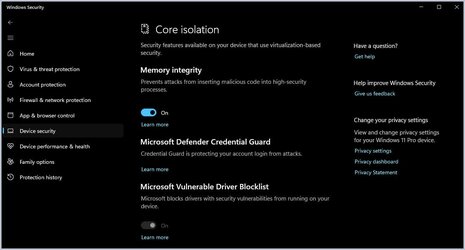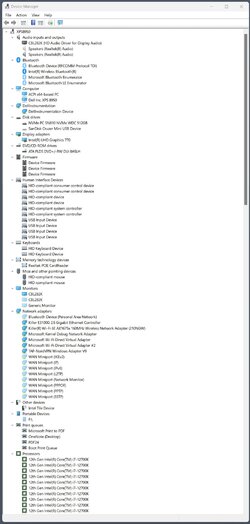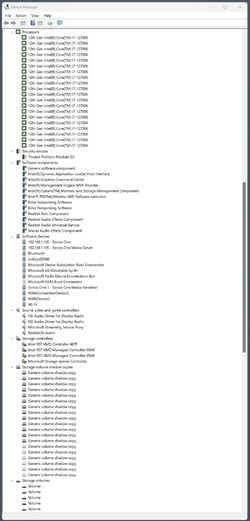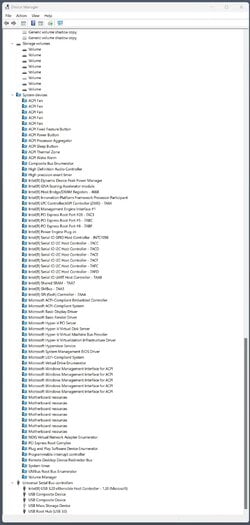Thanks again neves. The last line in SystemInfo reads:
> "Hyper-V Requirements: A hypervisor has been detected. Features required for Hyper-V will not be displayed."
As anything is possible in PCs, please be aware Hyper V should not be affecting the ability to enable Memory Integrity. I have the exact same reading as the OP, and yet Memory Integrity is enabled on my machine.That line is misleading - as in - it can mean a lot of things, such as:
- you have multiple virtualization apps installed - which is kinda like having multiple antivirus solutions installed (it can create conflicts - and thus as a preventive measure - one solution is disabled by default). Which is actually an official statement. ...


As to this...
- Hyper-V and all its features could actually be Missing/Disabled. Which easy to find out - by simply using Windows Search and opening the Windows Features tab - while typing the following: Turn Windows feature Then look for Hyper-V. Both features should be ticked. If Disabled from the BIOS/UEFI Hyper-V Platform feature - should be greyed out. If missing or disabled - you can also use the folowing comands to enabled them - while using windows CMD/Terminal ( with Admin privileges)
You would only need Hyper V if running any Virtual Machines. I myself run no Virtual Machines requiring Hyper V to be enabled, but simply enable it in the BIOS by default. Point... I have the same readings as the OP, yet my Memory Integrity is enabled.
All that said, what I find interesting is the missing faulty driver info (and why I asked to see Device Manager). There should be something there listing the affected driver. The fact that there is nothing there suggests (simply "my guess") the issue may actually be a "missing" driver, and why, I asked to see Device Manager.
Not saying Hyper V isn't the issue - It can be tested by simply disabling Hyper V (Virtualization) in the BIOS. If no change (still can't enable Memory Integrity), I'd move on from that train of thought. On the other hand, if the OP IS running VM software, they might check there.
My two cents.
My Computers
System One System Two
-
- OS
- Windows 11 Pro 23H2 (Build 22631.3296)
- Computer type
- PC/Desktop
- Manufacturer/Model
- Custom built
- CPU
- Intel i9-9900K
- Motherboard
- Gigabyte Aorus Z390 Xtreme
- Memory
- 32G (4x8) DDR4 Corsair RGB Dominator Platinum (3600Mhz)
- Graphics Card(s)
- Radeon VII
- Sound Card
- Onboard (ESS Sabre HiFi using Realtek drivers)
- Monitor(s) Displays
- NEC PA242w (24 inch)
- Screen Resolution
- 1920 x 1200
- Hard Drives
- 5 Samsung SSD drives: 2X 970 NVME (512 & 1TB), 3X EVO SATA (2X 2TB, 1X 1TB)
- PSU
- EVGA Super Nova I000 G2 (1000 watt)
- Case
- Cooler Master H500M
- Cooling
- Corsair H115i RGB Platinum
- Keyboard
- Logitech Craft
- Mouse
- Logitech MX Master 3
- Internet Speed
- 500mb Download. 11mb Upload
- Browser
- Microsoft Edge Chromium
- Antivirus
- Windows Security
- Other Info
- System used for gaming, photography, music, school.
-
- Operating System
- Win 10 Pro 22H2 (build 19045.2130)
- Computer type
- PC/Desktop
- Manufacturer/Model
- Custom Built
- CPU
- Intel i7-7700K
- Motherboard
- Gigabyte GA-Z270X-GAMING 8
- Memory
- 32G (4x8) DDR4 Corsair Dominator Platinum (3333Mhz)
- Graphics card(s)
- AMD Radeon R9 Fury
- Sound Card
- Onboard (Creative Sound Blaster certified ZxRi)
- Monitor(s) Displays
- Dell U2415 (24 inch)
- Screen Resolution
- 1920 x 1200
- Hard Drives
- 3 Samsung SSD drives: 1x 512gig 950 NVMe drive (OS drive), 1 x 512gig 850 Pro, 1x 256gig 840 Pro.
- PSU
- EVGA Super Nova 1000 P2 (1000 watt)
- Case
- Phantek Enthoo Luxe
- Cooling
- Corsair H100i
- Mouse
- Logitech MX Master
- Keyboard
- Logitech MK 710
- Internet Speed
- 100MB
- Browser
- Edge Chromium
- Antivirus
- Windows Security
- Other Info
- This is my backup system.





 Stay tuned.
Stay tuned.















